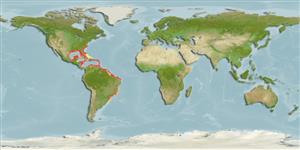Common names from other countries
>
Pleuronectiformes (Flatfishes) >
Cynoglossidae (Tonguefishes) > Symphurinae
Etymology: Symphurus: Greek, syn, symphysis = grown together + Greek, oura = tail (Ref. 45335); diomedeanus: Named for the Greek hero in the Trojan Was, Diomedes..
More on authors: Goode & Bean.
Environment: milieu / climate zone / depth range / distribution range
Ecologia
marinhas associadas(os) a recifes; intervalo de profundidade 6 - 263 m (Ref. 5951), usually 21 - 80 m (Ref. 26268). Subtropical; 36°N - 40°S, 98°W - 35°W (Ref. 26268)
Western Atlantic: Canada (Ref. 5951) to north of Cape Hatteras, North Carolina through the Gulf of Mexico and the Caribbean Sea, inner continental shelf of South America to about Isla de Flores, Uruguay.
Tamanho / Peso / Idade
Maturity: Lm ? range ? - ? cm
Max length : 22.0 cm TL macho/indeterminado; (Ref. 35237); common length : 18.0 cm TL macho/indeterminado; (Ref. 3716)
Espinhos dorsais (total) : 0; Raios dorsais (total) : 90 - 92; Espinhos anais: 0; Raios anais : 73 - 77.
Does not usually occur in shallow coastal or estuarine waters (Ref. 26268). Found on muddy bottoms. Feeds mainly on various benthic invertebrates particularly crabs and polychaete worms (Ref. 35237).
Ciclo de vida ou comportamento de acasalamento
Maturities | Reprodução | Spawnings | Egg(s) | Fecundities | Larvas
Robins, C.R. and G.C. Ray, 1986. A field guide to Atlantic coast fishes of North America. Houghton Mifflin Company, Boston, U.S.A. 354 p. (Ref. 7251)
Status na Lista Vermelha da UICN (Ref. 130435)
CITES (Ref. 128078)
Not Evaluated
Ameaça para os humanos
Harmless
Uso pelos humanos
Pescarias: de interesse potencial
Ferramentas
Relatórios especiais
Baixar XML
Fontes da internet
Estimates based on models
Preferred temperature (Ref.
115969): 19.7 - 27.5, mean 24.7 (based on 270 cells).
Índice de diversidade filogenética (Ref.
82804): PD
50 = 0.5000 [Uniqueness, from 0.5 = low to 2.0 = high].
Bayesian length-weight: a=0.01445 (0.00647 - 0.03228), b=3.05 (2.85 - 3.25), in cm Total Length, based on LWR estimates for this (Sub)family-body shape (Ref.
93245).
Nível Trófico (Ref.
69278): 3.3 ±0.46 se; based on food items.
Resiliência (Ref.
120179): Elevada, tempo mínimo de duplicação da população menor que 15 meses (Preliminary K or Fecundity.).
Fishing Vulnerability (Ref.
59153): Low vulnerability (12 of 100).
